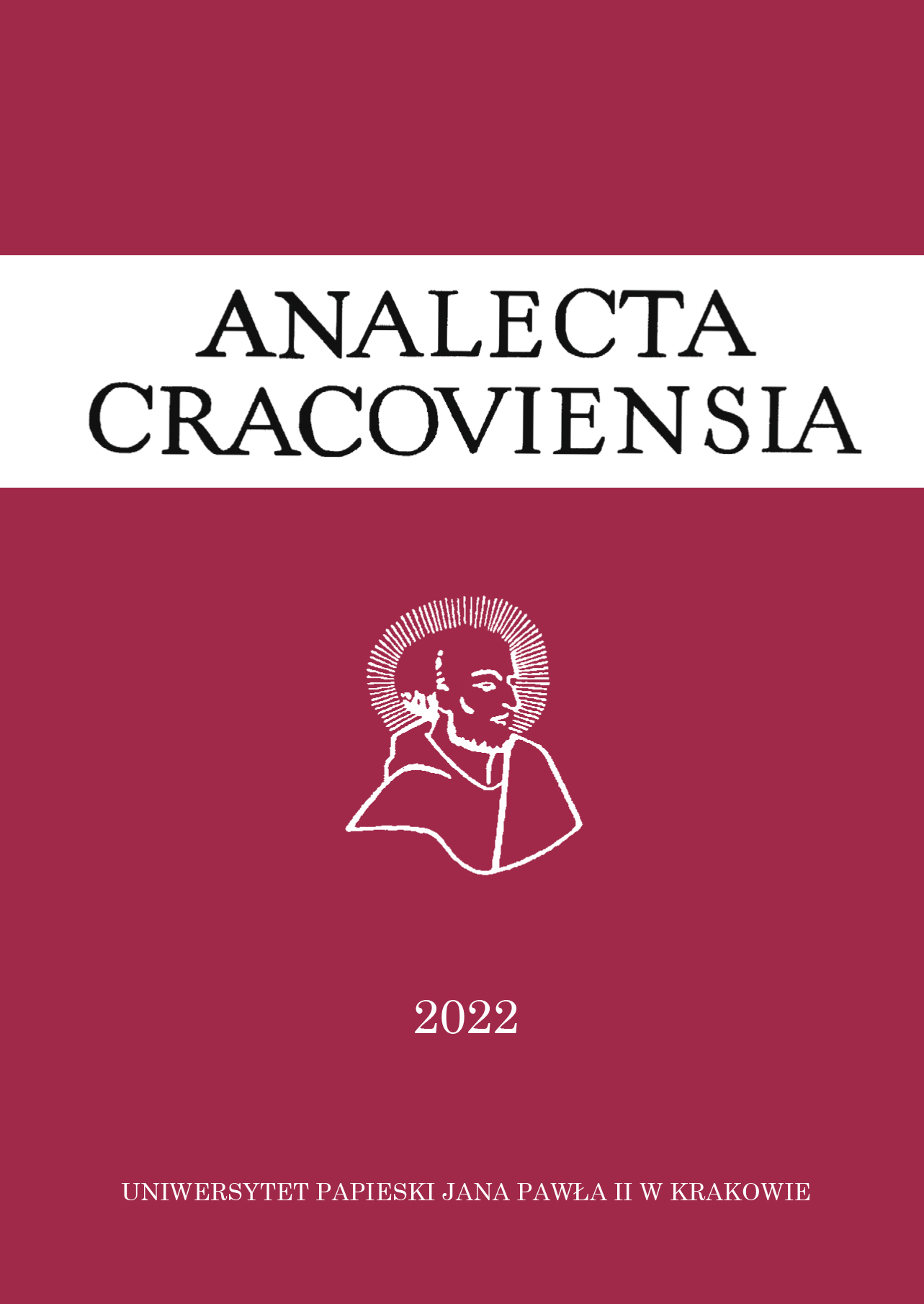Antidemonic character of the sacrament of marriage
DOI:
https://doi.org/10.15633/acr.5401Keywords:
the sacrament of marriage, marital unity, the relationship between Christ and the Church, SatanAbstract
Marriage, elevated by Christ to the rank of a sacrament, is not only God’s response to the split initiated by the devil’s temptation in the Garden of Eden, the restoration of the original unity and indissolubility, but it reflects the inner life and love of the Holy Trinity, which enables spouses to live in an attitude of total self-giving. The relationship of a woman and a man, based on faith, hope and love, is sanctified by the presence and constant accompaniment of the Spirit sent by the Father and Son, thanks to which their daily existential hardships and difficulties in spiritual struggle become possible to overcome. The sacrament of marriage, modelled on the close relationship between Christ and the Church and implementing this covenant of love, is a space for life, prayer and witness to God's love for spouses. As such, it is a rock against which the attacks of powers of darkness crash.
References
Barth G., Sakramentalność małżeństwa w relacji do Eucharystii, „Studia Teologii Dogmatycznej” 2 (2016), s. 68–85.
Benedykt XVI, Adhortacja apostolska Sacramentum Caritatis, Kraków 2007.
Breviarium fidei. Wybór doktrynalnych wypowiedzi Kościoła, red. I. Bokwa, Poznań 2007.
Celary I., Obraz małżeństwa sakramentalnego w misteriach Chrystusa w myśli teologicznej Jana Pawła II i Benedykta XVI, „Świat i Słowo” 2 (2010), s. 201–212.
Franciszek, Posynodalna adhortacja apostolska Amoris laetitia, http://www.vatican.va/content/francesco/pl/apost_exhortations/documents/papa-francesco_esortazione-ap_20160319_amoris-laetitia.html (23.05.2021).
Goffi T., Duchowość małżeńska, przeł. K. Kubis, Kraków 2001.
Grześkowiak J., Małżeństwo chrześcijan jako sakrament, „Seminare. Poszukiwania naukowe” 5 (1981), s. 41–59.
Guzowski K., Duch dialogujący, Lublin 2016.
International Theological Commission, The reciprocity between faith and sacraments in the sacramental economy, http://www.vatican.va/roman_curia/congregations/cfaith/cti_documents/rc_cti_20200303_reciprocita-fede-sacramenti_en.html (23.05.2021).
Jagodziński M., Komunijna wizja sakramentu małżeństwa, „Studia Teologii Dogmatycznej” 2 (2016), s. 48–67.
Jan Paweł II, Adhortacja apostolska Familiaris consortio, w: Adhortacje apostolskie Ojca Świętego Jana Pawła II, t. 1, Kraków 2006, s. 89–213.
Jan Paweł II, Adhortacja apostolska Reconciliatio et poenitentia, Libreria Editrice Vaticana 1984.
Jan Paweł II, Encyklika Evangelium vitae, w: Encykliki Ojca Świętego Jana Pawła II, Kraków 2005, s. 839–987.
Jan Paweł II, Encyklika Redemptor hominis, w: Encykliki Ojca Świętego Jana Pawła II, Kraków 2005, s. 5–76.
Jan Paweł II, Mężczyzną i niewiastą stworzył ich. Odkupienie ciała a sakramentalność małżeństwa, Lublin 2008.
Katechizm Kościoła Katolickiego, Poznań 1994.
Kiernikowski Z., Dwoje jednym ciałem w Chrystusie, Warszawa 2000.
Królikowski J., Trynitarno-chrystologiczne perspektywy teologii małżeństwa, „Studia Teologii Dogmatycznej” 2 (2016), s. 15–27.
Kunka S., Mężczyzna i kobieta obrazem Boga. Płeć a obraz Boży w człowieku, „Teologia w Polsce” 7 (2013) nr 2, s. 101–113.
Landwójtowicz P., Realizacja funkcji kapłańskiej w małżeństwie sakramentalnym, „Roczniki Teologiczne” 66 (2019) z. 6, s. 162–176.
Lipniak J. M., Małżeństwo w teologii Ortodoksyjnego Kościoła Koptyjskiego, „Studia Teologii Dogmatycznej” 2 (2016), s. 204–215.
Mariański J., Sakrament małżeństwa w świadomości katolików polskich w kontekście przemian rodziny, „Studia Teologii Dogmatycznej” 2 (2016), s. 143–169.
Mokrzycki B., Kościół w świętości, Warszawa 1984.
Müller G. L., Dogmatyka katolicka, przeł. W. Szymona, Kraków 2015.
Obrzędy sakramentu małżeństwa dostosowane do zwyczajów diecezji polskich, Katowice 2005.
Parzych-Blakiewicz K., Man in the „splendour of divinity”. The theological interpretation of „spousal love” in line with John Paul II’s theology of the body, „Teologia w Polsce” 14 (2020) nr 1, s. 89–102.
Parzych-Blakiewicz K., Sakramentalność małżeństwa w relacji do ludzkiej egzystencji, „Teologia w Polsce” 10 (2016) nr 1, s. 47–63.
Pius XI, Encyclical Casti connubii, http://www.vatican.va/content/pius-xi/en/encyclicals/documents/hf_p-xi_enc_19301231_casti-connubii.html (23.05.2021).
Proniewski A., Marital parenthood planning, „Studia Teologii Dogmatycznej” 2 (2016), s. 179–193.
Rychlicki C., Sakramentalny charakter przymierza małżeńskiego, Płock 1997.
Sienkiewicz E., Małżeńskie communio w sakramentalnym urzeczywistnieniu, „Studia Teologii Dogmatycznej” 2 (2016), s. 28–47.
Skreczko A., Marriage as a way to holiness, „Studia Teologii Dogmatycznej” 2 (2016), s. 194–203.
Skrzypczak R., Miłość warta obrączek, Gliwice 2018.
Sobór Watykański II, Konstytucja dogmatyczna o Kościele Lumen gentium, w: Konstytucje, dekrety, deklaracje, red. M. Przybył, Poznań 2002, s. 104–163.
Sobór Watykański II, Konstytucja duszpasterska o Kościele w świecie współczesnym Gaudium et spes, w: Konstytucje, dekrety, deklaracje, red. M. Przybył, Poznań 2002, s. 526–606.
Tomasz z Akwinu, Suma teologiczna, t. 32: Małżeństwo (Suppl. 41–68), przełożył i objaśnieniami zaopatrzył F. W. Bednarski OP, London 1982.
Downloads
Published
Issue
Section
License

This work is licensed under a Creative Commons Attribution 4.0 International License.
The author declares that he owns the copyright to the work (article) and that it is not limited in the scope covered by the above declaration and that the work (article) is an original work and does not infringe the copyright of other persons.
The author allows the Pontifical University of John Paul II in Krakow to use the paper free of charge, non-exclusive and unlimited in time by, i.e.:
– keeping in records and reproduction of the copies of the work using printing, reprography, magnetic recording and digital technology;
– trade in the original or copies on which the work has been recorded (introduction to the market, lending or rental of the original or copies, public exhibition, display, as well as making the work available to the public in such a way that everyone can have access to it in a place and at a time chosen by them);
– inclusion of the work in a collective work;
– granting by the Pontifical University of John Paul II in Krakow a Creative Commons Sub-licence Authorship Recognition-Non-commercial Use-No Subsidiaries 3.0 Poland
The Pontifical University of John Paul II in Krakow makes the work available on the Magazine Platform of the university under the Creative Commons Attribution-Non-commercial Use-No Subsidiary Works 3.0 Poland license.
Thus, it entitles all interested parties to use the work under the following conditions:
- the author and the title of the work will be given,
- the place of publication (journal title and internet address of the originally published work) will be indicated,
- the work will be distributed in a non-commercial manner,
- no dependent works will be created.

